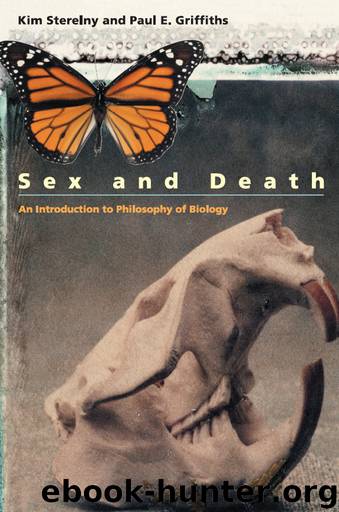Sex and Death: An Introduction to Philosophy of Biology by Kim Sterelny & Paul E. Griffiths

Author:Kim Sterelny & Paul E. Griffiths [Sterelny, Kim]
Language: eng
Format: epub, pdf
Publisher: The University of Chicago Press
Published: 1999-10-02T16:00:00+00:00
10.2 Function
The function of the heart is to pump blood. The heart also makes noises, but that is not part of its function. The function of the brow-raising response to surprise is to increase the visual field. This response also stretches the skin, but that is not part of its function. Distinctions like these are common in biology, but their equivalents in the physical sciences would seem bizarre. Physics does not tell us what the sun is “for.” The sun has all sorts of effects, but there is no distinction between the effects it is “meant” to have and those that are accidental side effects. In an earlier phase of human thought we could have made such distinctions. The sun was created by God to warm the earth, and the fact that it warms Mars, where there are no creatures with souls, is a side effect. But the rise of modern science was marked by the expulsion of explanations in terms of purpose or function in favor of explanations in terms of natural laws. The sun came into existence because the expansion of matter from the Big Bang was not entirely regular, and all its effects, useful or useless, are equally unintended.
The conventional explanation of this difference between biology and physics is that biology studies the products of natural selection, while physics does not. Talking about functions is just a convenient way of talking about adaptations. If brow raising in surprise is an adaptation for increasing the visual field, then its function is to increase the visual field. Stretching the skin around the eyes has no known connection to reproductive fitness, so brow raising is probably not an adaptation for skin stretching, and skin stretching is not one of its functions. This view of function has been common among biologists for a long time. The architects of the received view even introduced a new name, teleonomy, to distance this biological understanding of functions and purposes from more traditional teleological ideas (Pittendrigh 1958). Konrad Lorenz, the co-founder of modern animal behavior studies (ethology), describes this perspective very clearly:
If we ask “What does a cat have sharp, curved claws for?” and answer simply “To catch mice with,” this does not imply a profession of any mythical teleology, but the plain statement that catching mice is the function whose survival value, by the process of natural selection, has bred cats with this particular form of claw. Unless selection is at work, the question “What for?” cannot receive an answer with any real meaning. (Lorenz 1966, 9)
Philosophers call this the etiological theory of biological functions. An etiological theory explains something in terms of its origins, or etiology—in this case, its evolutionary origins. The functions of a biological trait are those effects for which it is an adaptation. A distinctive feature of the etiological theory is that a trait can have functions that it is unable to perform. The function of the white coat of a polar bear is to make the bear harder to see.
Download
Sex and Death: An Introduction to Philosophy of Biology by Kim Sterelny & Paul E. Griffiths.epub
Sex and Death: An Introduction to Philosophy of Biology by Kim Sterelny & Paul E. Griffiths.pdf
This site does not store any files on its server. We only index and link to content provided by other sites. Please contact the content providers to delete copyright contents if any and email us, we'll remove relevant links or contents immediately.
| Anatomy | Animals |
| Bacteriology | Biochemistry |
| Bioelectricity | Bioinformatics |
| Biology | Biophysics |
| Biotechnology | Botany |
| Ecology | Genetics |
| Paleontology | Plants |
| Taxonomic Classification | Zoology |
Sapiens: A Brief History of Humankind by Yuval Noah Harari(14250)
The Tidewater Tales by John Barth(12608)
Mastermind: How to Think Like Sherlock Holmes by Maria Konnikova(7227)
Do No Harm Stories of Life, Death and Brain Surgery by Henry Marsh(6890)
The Thirst by Nesbo Jo(6826)
Why We Sleep: Unlocking the Power of Sleep and Dreams by Matthew Walker(6618)
Life 3.0: Being Human in the Age of Artificial Intelligence by Tegmark Max(5474)
Sapiens by Yuval Noah Harari(5294)
The Longevity Diet by Valter Longo(5019)
The Body: A Guide for Occupants by Bill Bryson(4974)
The Rules Do Not Apply by Ariel Levy(4859)
The Immortal Life of Henrietta Lacks by Rebecca Skloot(4525)
Animal Frequency by Melissa Alvarez(4395)
Why We Sleep by Matthew Walker(4360)
The Hacking of the American Mind by Robert H. Lustig(4318)
Yoga Anatomy by Kaminoff Leslie(4305)
All Creatures Great and Small by James Herriot(4232)
Double Down (Diary of a Wimpy Kid Book 11) by Jeff Kinney(4207)
Barron's AP Biology by Goldberg M.S. Deborah T(4096)
